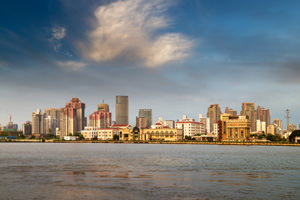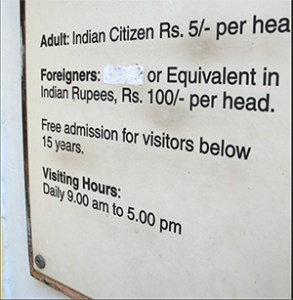 In our last blog post, we explored international etiquette and the trends in global tipping. A survey conducted by MasterCard Worldwide explored the tipping practices in 14 Asian countries. As global tipping practices continue to evolve, it’s especially interesting to note customs on the subcontinent of India.
In our last blog post, we explored international etiquette and the trends in global tipping. A survey conducted by MasterCard Worldwide explored the tipping practices in 14 Asian countries. As global tipping practices continue to evolve, it’s especially interesting to note customs on the subcontinent of India.
On her 2012 trip to southern India, my co-author Dr. Liz Alexander was amused to see the sign (below) at the entrance to Mysore Palace in the state of Karnataka. The contrast between locals paying 5 rupees per head and foreigners paying 100 rupees speaks to the differences that exist between country economies and cost of living. And that’s a moving target, given fluctuating exchange rates, as we found recently when including information about bill-paying and tipping in our best-selling book Access to Asia: Your Multicultural Guide to Building Trust, Inspiring Respect, and Creating Long-Lasting Business Relationships (Wiley, 2015)

Over the past three years, Liz has visited southern India five times, and with each trip it becomes more noticeable that the cost of living has increased. This invariably affects tipping for services, so make sure that what you tip meets cultural expectations to save both parties embarrassment. As a mutual Indian friend in Chennai pointed out:
“My brother had come home to India from the U.S. for a week. He had given 750 rupees (approx. US$10.00) each to my cook and my maid, whereas he had given 1000 rupees (US$15.60) to my driver. The driver had helped my brother in taking him places and bringing him some of the things he required. Of course, this is over and above the over time charges that we would be paying my driver.”
Given that guidelines for tipping evolve, what should you do? Research before your departure to understand cultural expectations for the part of India you’ll be visiting. You can also use this approximate guideline as a starting place:
- Hotels: Most include a service charge of approximately 10% and tax in the hotel bill.
- Restaurants: Most include service charge and tax in the bill; an extra tip is discretionary, and 10% is the amount recommended in larger metropolitan areas.
- Auto-rickshaw or taxi: Round up to the nearest rupee or dollar.
- Hotel Bellmen: $1.00US or 20-25 rupees; small change is discretionary.
- Housekeeping: $1-2.00US; this is discretionary.
- Tour Guides: Discretionary depending on the length of the tour.
It’s a good idea to carry small change to tip those who assist when you are out and about or who pose for photographs. Remember that India is a vast subcontinent where expectations and practices in northern cities like Delhi and Kolkata are very different from those in the south, like Bangalore and Chennai, or even cities in the mid-regions like Mumbai and Hyderabad. Don’t be afraid to ask your Indian hosts what is expected for services.
Sharon Schweitzer JD is a recognized international etiquette expert, an on-air contributor, corporate trainer, and the international award winning author of Access to Asia: Your Multicultural Guide to Building Trust, Inspiring Respect and Creating Long Lasting Business Relationships. Her work and travels have taken her to over 60 countries on seven continents. With over 20 years’ experience providing consulting and training to more than 100,000 attorneys and corporate executives in law firms and global corporations, her clients range from MD Anderson to Charles University in Prague and NFP. She has been quoted by the New York Times, Fortune Magazine, and numerous international media outlets. To learn more about Sharon, connect with her at www.sharonschweitzer.com; follow her on Twitter at www.twitter.com/austinprotocol and Facebook at www.facebook.com/protocolww.

Leave A Comment